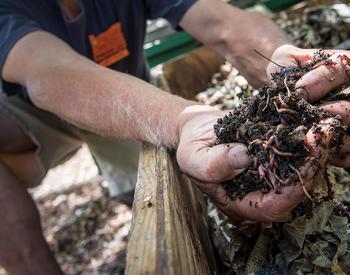How To Make Red Clay Soil Into Good Garden Soil
CORVALLIS - When you walk about your yard on a wet day, do your shoes stick in the mud? Could you make ceramic pots out of the soil in your garden? Odds are you have clay soil, one of the biggest challenges to the home gardener.
Finely textured clay soils are difficult to work up and develop into a good seedbed. If the clay is dry, it tends to be very hard and lumpy. If it is wet, it tends to be very sticky and difficult to manipulate. It seems like a gardener's nightmare.
But clay soils have their attributes, says Linda Brewer, teaching assistant in the Department of Soil Science at Oregon State University.
"Clay soils hold huge amounts of plant nutrients because they have elevated cation exchange capacities," said Brewer. This means they are able to hold on to nutrients, fertilizer and pesticides.
Another plus for clay soils is that they hang onto water really well.
"Clay soils hold huge amounts of water at very high tensions because the spaces between the clay particles are so fine," explained Brewer. "The largest clay particle is more than 1,000 times smaller than the smallest sand particle."
The best way to improve clay soils is to mix organic materials thoroughly with existing soil, explained Brewer.
Bark, sawdust, manure, leaf mold, compost and peat moss are among the organic amendments commonly used to improve clay soil. Two or three inches of organic materials should be spread and rototilled, forked or dug into the top six or seven inches of your garden beds.
"Clay soils are highly structured at the atomic level, much as crystals are," said Brewer. "No amount of sand can be added to a clay soil to change its texture. The large sand particles tend to provide a surface onto which the tiny clay particles adhere. The result can be a more difficult soil to manage than the original clay."
When a large amount of organic material is added to the soil, microorganisms multiply rapidly. Since they construct their bodies from the same nutrients that plants use, soil nutrients can be relatively unavailable for a time after an addition of manure or compost. This condition may persist until the organic material is broken down and nutrients are released.
To overcome the temporary lack of nutrients, gardeners might try adding low nitrogen organic material to the soil in the autumn, or smaller amounts at a time in the spring, when warm weather will hasten break down. Or sprinkle in some fertilizer, such as ammonium sulfate at the time of tilling to give an immediate source of nutrients.
Organic matter in soil serves as food for earthworms, insects, bacteria and fungi-they transform it to soil nutrients and humus. Through this decomposition process, materials are made available as foods to growing plants. In finely textured clay soils, organic material creates aggregates of the soil particles, improving drainage and making it easier to work. Earthworms are especially helpful in making and keeping soil porous and well draining, said Brewer.
Fertile soil with good tilth does not come about with a single or even several additions of organic material, but from a consistent soil-building program. "Repeated additions of organic matter do change the physical properties of clay soils on a broader level, but these additions must be regular in order to maintain the changes," said Brewer.
"There's no break for people who garden in clay," she said with a laugh.

Want to learn more about this topic? Explore more resources from OSU Extension: Garden Soil and Compost
How To Make Red Clay Soil Into Good Garden Soil
Source: https://extension.oregonstate.edu/news/theres-no-break-people-who-garden-clay#:~:text=Bark%2C%20sawdust%2C%20manure%2C%20leaf,inches%20of%20your%20garden%20beds.
Posted by: powellwereft.blogspot.com

0 Response to "How To Make Red Clay Soil Into Good Garden Soil"
Post a Comment